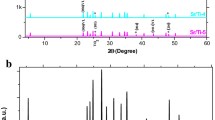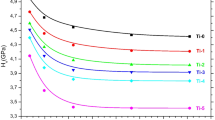Abstract
This comprehensive study delves into the differentiation of mechanical performance and mechanical characteristics of Bi-site Si partial substituted Bi2.1−xSixSr2.0Ca1.1Cu2.0Oy superconducting ceramic materials with the assistant of Vickers microhardness measurements performed at the indentation test loads intervals 0.245 N–2.940 N. It is found that the propagations of voids, dislocations and cracks in the Bi-2212 crystal lattice accelerate dramatically because of the dramatic increment in the sizes of crack-producing omnipresent flaws, crack initiation sites, stress concentration regions, strain fields and stress raisers in the crystal matrix with enhancing the Si/Bi partial substitution level. Hence, the presence of Si inclusions in the Bi-2212 superconducting crystal structure makes the active and independent slip systems cancel immediately, and the cracks locate more rapidly into the critical propagation speed. The load required to break the material diminishes due to the reduced durable tetragonal phase. Namely, the Si inclusions favor considerably the intergranular fracture in the host crystal matrix. Besides, it is noted that the sensitivity to the applied load raises remarkably with the substitution level due to the entanglement of dislocations and cracks with each other. As for the mechanical characterization, all the materials studied exhibit the standard indentation size effect behavior (ISE nature) but in the reduction trend with the substitution level. All the findings are also supported by the bulk density and residual porosity parameters. The bulk density experimental results confirm the regression of elastic properties and fracture strength with the Si/Bi substitution level. At the same time, we survey the original mechanical hardness parameters at the vicinity of plateau limit regions via the Hays–Kendall (HK) and indentation-induced cracking (IIC) approaches for the first time. According to the experimental measurement results, the IIC model is observed to be the best theoretical model to discuss the load-independent Vickers hardness parameters of Bi-site Si partial substituted Bi-2212 ceramic compounds.



Similar content being viewed by others
References
H.K. Onnes, Further experiments with liquid helium. D. On the change of electrical resistance of pure metals at very low temperatures, etc. V. The disappearance of the resistance of mercury. K. Ned. Akad. Wet. Proc. 14, 113–115 (2011)
T. Turgay, G. Yildirim, effect of diffusion annealing temperature on crack-initiating omnipresent flaws, void/crack propagation and dislocation movements along Ni surface-layered Bi-2223 crystal structure. Sak. Univ. J. Sci. 22, 1211–1220 (2018)
W. Meissner, R. Ochsenfeld, Ein neuer effekt bei eintritt der supraleitfähigkeit. Naturwissenschaften 21, 787–788 (1933)
J.D. Hodge, H. Muller, D.S. Applegate, Q. Huang, A resistive fault current limiter based on high temperature superconductors. Appl. Supercond. 3, 469–482 (1995)
S.Y. Oh, H.R. Kim, Y.H. Jeong, O.B. Hyun, C.J. Kim, Joining of Bi-2212 high-T-c superconductors and metals using indium solders. Physica C 463–465, 464–467 (2007)
M. Chen, W. Paul, M. Lakner, L. Donzel, M. Hoidis, P. Unternaehrer, R. Weder, M. Mendik, 6.4 MVA resistive fault current limiter based on Bi-2212 superconductor. Physica C 372, 1657–1663 (2002)
K. Koyama, S. Kanno, S. Noguchi, Electrical, magnetic and superconducting properties of the quenched Bi2Sr2Ca1−XNdXCu2O8+y system. Jpn. J. Appl. Phys. 29, L53–L56 (1990)
A.T. Ulgen, T. Turgay, C. Terzioglu, G. Yildirim, M. Oz, Role of Bi/Tm substitution in Bi-2212 system on crystal structure quality, pair wave function and polaronic states. J. Alloys Compd. 764, 755–766 (2018)
S.B. Guner, Y. Zalaoglu, T. Turgay, O. Ozyurt, A.T. Ulgen, M. Dogruer, G. Yildirim, A detailed research for determination of Bi/Ga partial substitution effect in Bi-2212 superconducting matrix on crucial characteristic features. J. Alloys Compd. 772, 388–398 (2019)
H. Miao, M. Meinesz, B. Czabai, J. Parrell, S. Hong, Microstructure and Jc improvements in multifilamentary Bi-2212/Ag wires for high field magnet applications. AIP Conf. Proc. 986, 423–430 (2008)
W. Buckel, R. Kleiner, Superconductivity: Fundamentals and Applications, 2nd edn. (Wiley-VCH, Weinheim, 2004)
H.H. Xu, L. Cheng, S.B. Yan, D.J. Yu, L.S. Guo, X. Yao, Recycling failed bulk YBCO superconductors using the NdBCO/YBCO/MgO film-seeded top-seeded melt growth method. J. Appl. Phys. 111, 103910 (2012)
K.Y. Choi, I.S. Jo, S.C. Han, Y.H. Han, T.H. Sung, M.H. Jung, G.S. Park, S.I. Lee, High and uniform critical current density for large-size YBa2Cu3O7−δ single crystals. Curr. Appl. Phys. 11, 1020–1023 (2011)
T.A. Coombs, A finite element model of magnetization of superconducting bulks using a solid-state flux pump. IEEE Trans. Appl. Supercond. 21, 3581–3586 (2011)
G. Yildirim, Determination of optimum diffusion annealing temperature for Au surface-layered Bi-2212 ceramics and dependence of transition temperatures on disorders. J. Alloys Compd. 699, 247–255 (2017)
F.N. Werfel, U. Floegel-Delor, R. Rothfeld, T. Riedel, B. Goebel, D. Wippich, P. Schirrmeister, Superconductor bearings, flywheels and transportation. Supercond. Sci. Technol. 25, 014007 (2012)
Y. Zalaoglu, T. Turgay, F. Karaboga, G. Yildirim, Changes of fundamental characteristic properties depending on Si/Bi substitution level, in 3rd International Mediterranean Science and Engineering Congress (IMSEC 2018), Paper ID: 451t, pp. 1704–1708
Y. Zalaoglu, T. Turgay, G. Yildirim, A detailed analysis founded on powder X-ray diffraction for (Bi2.1–xSix)Sr2.0Ca1.1Cu2.0Oy, in 3rd International Mediterranean Science and Engineering Congress (IMSEC 2018., Paper ID: 452t, pp. 1149–1154
K. Sangwal, On the reverse indentation size effect and microhardness measurement of solids. Mater. Chem. Phys. 63, 145–152 (2000)
R. Awad, A.I. Abou-Aly, M. Kamal, M. Anas, Mechanical properties of (Cu0.5Tl0.5)-1223 substituted by Pr. J. Supercond. Nov. Magn. 24, 1947–1956 (2011)
A.A. Elmustafa, D.S. Stone, Nanoindentation and the indentation size effect: kinetics of deformation and strain gradient plasticity. J. Mech. Phys. Solid. 5, 357–381 (2003)
N.K. Saritekin, M. Pakdil, E. Bekiroglu, G. Yildirim, Examination of effective nucleation centers for flux pinning of vortices and optimum diffusion annealing temperature for Au-diffusion-doped Bi-2212 polycrystalline compound. J. Alloys Compd. 688, 637–646 (2016)
W. Abdeen, S. Marahba, R. Awad, A.I. Abou Aly, I.H. Ibrahim, M. Matar, Electrical and mechanical properties of (Bi, Pb)-2223 substituted by holmium. J. Adv. Ceram. 5, 54–69 (2016)
C.J. Poole, H.A. Farach, R. Creswick, Superconductivity (Academic Press, San Diego, 1995)
R.R. Reddy, M. Murakami, S. Tanaka, P.V. Reddy, Elastic behavior of a Y-Ba-Cu-O sample prepared by the MPMG method. Physica C 257, 137–142 (1996)
K. Kocabas, M. Ciftcioglu, The effect of Sb substitution of Cu in Bi1.7Pb0.3Sr2Ca2Cu3–xSbxOy superconductors. Phys. Status Solidi A 177, 539–545 (2000)
W.D. Callister Jr., D.G. Rethwisch, Materials Science and Engineering: An Introduction, 9th edn. (Wiley, New York, 2013)
M. Dogruer, C. Terzioglu, G. Yildirim, M. Pakdil, Y. Zalaoglu, Decrement of crack propagation in bulk Bi-2223 superconducting ceramics with Sn-diffusion annealing temperature. J. Mater. Sci. Mater. Electron. 26, 6013–6019 (2015)
Y. Zalaoglu, B. Akkurt, M. Oz, G. Yildirim, Transgranular region preference of crack propagation along Bi-2212 crystal structure due to Au nanoparticle diffusion and modeling of new systems. J. Mater. Sci. Mater. Electron. 28, 12839–12850 (2017)
N.K. Saritekin, H. Bilge, M.F. Kahraman, Y. Zalaoglu, M. Pakdil, M. Dogruer, G. Yildirim, M. Oz, Improvement of mechanical characteristics and performances with Ni diffusion mechanism throughout Bi-2223 superconducting matrix. AIP Conf. Proc. 1722, 140007 (2016)
C. Hays, E.G. Kendall, An analysis of Knoop microhardness. Metallography 6, 275–282 (1973)
M. Dogruer, O. Gorur, F. Karaboga, G. Yildirim, C. Terzioglu, Zr diffusion coefficient and activation energy calculations based on EDXRF measurement and evaluation of mechanical characteristics of YBa2Cu3O7 – x bulk superconducting ceramics diffused with Zr nanoparticles. Powder Technol. 246, 553–560 (2013)
B. Akkurt, G. Yildirim, Change of mechanical performance and characterization with replacement of Ca by Gd nanoparticles in Bi-2212 system and suppression of durable tetragonal phase by Gd. J. Mater. Sci. Mater. Electron. 27, 13034–13043 (2016)
H. Li, R.C. Bradt, The effect of indentation-induced cracking on the apparent microhardness. J. Mater. Sci. 31, 1065–1070 (1996)
Author information
Authors and Affiliations
Corresponding author
Additional information
Publisher’s Note
Springer Nature remains neutral with regard to jurisdictional claims in published maps and institutional affiliations.
Rights and permissions
About this article
Cite this article
Turgay, T., Yildirim, G. Effect of aliovalent Si/Bi partial substitution on propagation mechanisms of cracking and dislocation in Bi-2212 crystal system. J Mater Sci: Mater Electron 30, 7314–7323 (2019). https://doi.org/10.1007/s10854-019-01044-2
Received:
Accepted:
Published:
Issue Date:
DOI: https://doi.org/10.1007/s10854-019-01044-2




